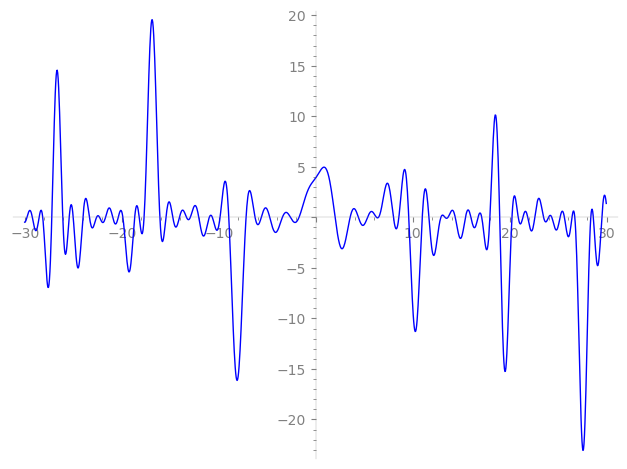| L(s) = 1 | + (2.13 − 1.55i)2-s + (1.53 − 4.72i)4-s + (2.49 + 1.81i)5-s + (−0.309 + 0.951i)7-s + (−2.42 − 7.45i)8-s + 8.14·10-s + (−1.45 + 2.98i)11-s + (4.56 − 3.31i)13-s + (0.815 + 2.51i)14-s + (−8.70 − 6.32i)16-s + (−4.53 − 3.29i)17-s + (0.0379 + 0.116i)19-s + (12.3 − 9.00i)20-s + (1.51 + 8.62i)22-s − 1.67·23-s + ⋯ |
| L(s) = 1 | + (1.51 − 1.09i)2-s + (0.767 − 2.36i)4-s + (1.11 + 0.810i)5-s + (−0.116 + 0.359i)7-s + (−0.856 − 2.63i)8-s + 2.57·10-s + (−0.438 + 0.898i)11-s + (1.26 − 0.919i)13-s + (0.218 + 0.671i)14-s + (−2.17 − 1.58i)16-s + (−1.09 − 0.798i)17-s + (0.00869 + 0.0267i)19-s + (2.77 − 2.01i)20-s + (0.323 + 1.83i)22-s − 0.348·23-s + ⋯ |
\[\begin{aligned}\Lambda(s)=\mathstrut & 693 ^{s/2} \, \Gamma_{\C}(s) \, L(s)\cr =\mathstrut & (0.149 + 0.988i)\, \overline{\Lambda}(2-s) \end{aligned}\]
\[\begin{aligned}\Lambda(s)=\mathstrut & 693 ^{s/2} \, \Gamma_{\C}(s+1/2) \, L(s)\cr =\mathstrut & (0.149 + 0.988i)\, \overline{\Lambda}(1-s) \end{aligned}\]
Particular Values
| \(L(1)\) |
\(\approx\) |
\(2.96052 - 2.54603i\) |
| \(L(\frac12)\) |
\(\approx\) |
\(2.96052 - 2.54603i\) |
| \(L(\frac{3}{2})\) |
|
not available |
| \(L(1)\) |
|
not available |
\(L(s) = \displaystyle \prod_{p} F_p(p^{-s})^{-1} \)
| $p$ | $F_p(T)$ |
|---|
| bad | 3 | \( 1 \) |
| 7 | \( 1 + (0.309 - 0.951i)T \) |
| 11 | \( 1 + (1.45 - 2.98i)T \) |
| good | 2 | \( 1 + (-2.13 + 1.55i)T + (0.618 - 1.90i)T^{2} \) |
| 5 | \( 1 + (-2.49 - 1.81i)T + (1.54 + 4.75i)T^{2} \) |
| 13 | \( 1 + (-4.56 + 3.31i)T + (4.01 - 12.3i)T^{2} \) |
| 17 | \( 1 + (4.53 + 3.29i)T + (5.25 + 16.1i)T^{2} \) |
| 19 | \( 1 + (-0.0379 - 0.116i)T + (-15.3 + 11.1i)T^{2} \) |
| 23 | \( 1 + 1.67T + 23T^{2} \) |
| 29 | \( 1 + (2.73 - 8.41i)T + (-23.4 - 17.0i)T^{2} \) |
| 31 | \( 1 + (1.29 - 0.939i)T + (9.57 - 29.4i)T^{2} \) |
| 37 | \( 1 + (-1.28 + 3.96i)T + (-29.9 - 21.7i)T^{2} \) |
| 41 | \( 1 + (1.07 + 3.31i)T + (-33.1 + 24.0i)T^{2} \) |
| 43 | \( 1 + 5.10T + 43T^{2} \) |
| 47 | \( 1 + (-0.492 - 1.51i)T + (-38.0 + 27.6i)T^{2} \) |
| 53 | \( 1 + (9.59 - 6.96i)T + (16.3 - 50.4i)T^{2} \) |
| 59 | \( 1 + (2.04 - 6.29i)T + (-47.7 - 34.6i)T^{2} \) |
| 61 | \( 1 + (-6.86 - 4.98i)T + (18.8 + 58.0i)T^{2} \) |
| 67 | \( 1 + 8.04T + 67T^{2} \) |
| 71 | \( 1 + (-5.05 - 3.67i)T + (21.9 + 67.5i)T^{2} \) |
| 73 | \( 1 + (-1.08 + 3.33i)T + (-59.0 - 42.9i)T^{2} \) |
| 79 | \( 1 + (-7.60 + 5.52i)T + (24.4 - 75.1i)T^{2} \) |
| 83 | \( 1 + (7.63 + 5.54i)T + (25.6 + 78.9i)T^{2} \) |
| 89 | \( 1 - 8.45T + 89T^{2} \) |
| 97 | \( 1 + (-4.59 + 3.34i)T + (29.9 - 92.2i)T^{2} \) |
| show more | |
| show less | |
\(L(s) = \displaystyle\prod_p \ \prod_{j=1}^{2} (1 - \alpha_{j,p}\, p^{-s})^{-1}\)
Imaginary part of the first few zeros on the critical line
−10.65593671325957330519034378964, −9.861556794313192276157494977964, −8.961736929533315102910029443175, −7.18046218445967376252394561112, −6.25380009820777376689905416460, −5.61082998260087726744834448476, −4.73891234889331716256543712254, −3.43773784162230173218494488749, −2.60501277441316605336811534662, −1.72212086914889846494577917093,
1.99626909885822415255766130199, 3.54609688774166454286043075321, 4.40072879354199614398104185865, 5.34334142171362973915489187706, 6.26858269359739664501453838377, 6.46687749130583347091904918145, 8.011438802628471679739934621842, 8.568633110530744834074629993232, 9.590150406435257487848376486113, 10.98115514622089138174481926535

